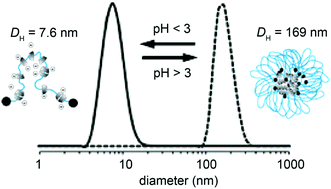Polyrotaxanes are an exciting class of materials that in recent years have found applications in self-healing materials, coatings, nanomedicine, and biomaterials. This interesting supramolecular polymer architecture conveys unusual and dynamic properties not found in conventional covalently bonded polymer materials.

Fig. 1 DLS (number) analysis of PRX 5 (0.1 mg mL−1 ) at pH 7.2 (continuous line) and the self-assembly of PRX 5 into SA-PRX 5 at pH 2 (dashed line).
Commercially available PEG of 10 and 20 kDa were threaded into CDs with two different threading degrees of 28% and 65%. The CDs were modified with succinic anhydride to give approximately 4 carboxylic acid groups per CD ring.
At neutral pH, the 28% threaded polyrotaxanes formed self-assembled nanoparticles due to movement of the CD units along polymer chains to form segregated regions of more hydrophobic CD in the core and PEG chains at the periphery. When the pH of the polymer solution was less than 3 the subsequently charged CDs electrostatically repel each other and the nanoparticles fall apart to give their corresponding unimolecular polyrotaxanes in an extended conformation. By cycling the pH of the polyrotaxane system, nanoparticles can be formed and disassembled up to three times.
These nanoparticles are proposed to be of interest and significance for oral drug delivery systems that could be responsive to the lumen of the stomach (pH 1 – 3.8), and thus release therapeutics when the nanoparticles dissociate at low pH values.
Nanoparticles assembled via pH-responsive reversible segregation of cyclodextrins in polyrotaxanes
Blaise L. Tardy, Shereen Tan, Henk H. Dam, Hirotaka Ejima, Anton Blencowe, Greg G. Qiao and Frank Caruso
Nanoscale, 2016, Advance Article, DOI: 10.1039/C6NR04841B
Alexander Cook is a guest web writer for the RSC journal blogs. He is a PhD researcher in the Perrier group at the University of Warwick, focusing on polymer materials and their use in various applications. Follow him on twitter @alexcook222










